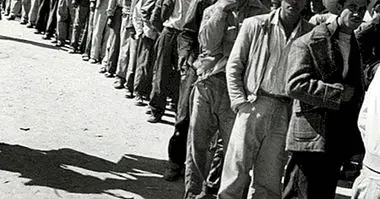Frequent development of workplace harassment: 3 phases
Workplace harassment, also called mobbing, is a subtle form of violence that is exerted in work environments. Many times, and sometimes for spurious reasons, companies or organizations, aggressors and observers or witnesses use euphemisms to refer to this type of violence.
Thus, words such as "labor conflict", "power struggles", "peer fights", "incompatible characters", etc. are used, as if these problems were something isolated among workers or had more to do with the normal dynamics within of the organizations.
But the truth is that Workplace harassment goes beyond a mere conflictual relationship between peers . Let's dig deeper into the characteristics of this kind of problems.
- Related article: "The 11 types of violence (and the different kinds of aggression)"
Characteristics of mobbing
At least three distinctive characteristics of workplace harassment can be identified.
1. Violence is exercised towards a victim who barely puts up resistance
In addition, there are often witnesses to this violence who will look the other way, avoiding interfering in the matter or, if they do, they will take sides with the aggressor.
2. It is systematic and repeated violence over time
However, they are usually episodes of medium or low intensity. Sometimes they are reduced only to phrases and comments that could be judged as inconsequential by an outside observer. Acts of high intensity violence are rare.
However, it is precisely this low intensity and repetition that makes the situation more dangerous in the medium term (by way of comparison we could compare it with the torture of the "Chinese drop").
3. Violence is exercised intentionally and with a purpose
The victim may not realize or understand such hidden interests . It is also possible that observers do not understand them, either because they avoid paying attention to the situation of injustice or because often the acts of aggression are subtle and are only perceived by the victim.
To achieve that goal, the stalker follows a series of strategies that go through isolation, hostility, loss of prestige and other forms of psychological violence.
- Maybe you're interested: "Mobbing: psychological harassment at work"
Development of workplace harassment
These acts of violence exercised continuously cause significant damage to health and other types of economic and social damage . Workplace harassment could be understood as a process extended in time in which the victim goes through a series of stages that leave different psychological sequelae.
A possible course could be, for example, the following one.
1. Stage of underestimating the damage
At the beginning of the labor harassment the worker think that it is a temporary situation due to a problem or a misunderstanding that prevent him from being on guard and taking measures to defend himself.
2. Blaming yourself
Later, once he perceives that he understands that the situation will not stop, he may ask "why me?" what erodes their self-esteem because he attributes harassment to certain characteristics of his personality, blaming himself for it.
In these initial stages it is not uncommon for the victim to ask himself, too, if he is not being too sensitive or exaggerated in the face of the situation. The fact that the episodes have a low intensity that many times only the victim perceives has to do with these thoughts. This begins to doubt their own perceptions which can lead to a phenomenon known as "derealization" (a perception of the outside world as something strange or unreal).
3. Anxiety
The continuity of the harassment over time causes anxiety and depressive symptoms, which, in turn, worsens the situation partly because facilitates the impunity of the aggressor that justifies their behavior based on the problematic situation that the victim goes through.
It is also frequent the "somatization" of the experience that, together with the stress it creates, can cause stomach pains, skin irritations, headaches, etc.
In short, workplace harassment has much more serious consequences for the victim than a simple "labor conflict".



















